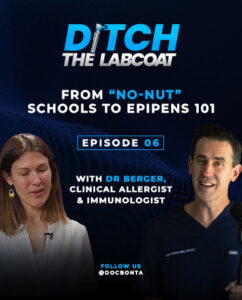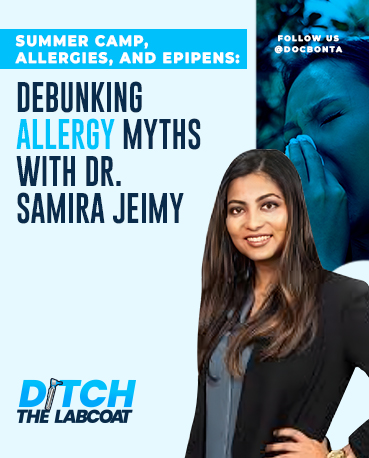Since a podcast is only audio, you could not experience the blazing heat that was making the air shimmer on this beautiful summer day when we shot the pod. Ah, summer. That magical time when the kids are thrilled to be out of school, and parents like me are frantically packing bags for day camps filled with water shoes, sunscreen, and snacks that *hopefully* won’t spark a catastrophe. But if you’re like me, you’ve probably had a mini panic attack while making your kid a classic PB&J, wondering, “Is this sandwich going to make someone collapse at camp?”
Lucky for us, this episode of the Ditch the Lab Coat podcast features Dr. Samira Jeimy, allergist extraordinaire, here to set the record straight on everything allergy related. From whether nut-free schools are doing more harm than good to the great EpiPen expiration debate, this conversation was equal parts informative, myth-busting, and—let’s face it—downright entertaining.
So, let’s unpack the juicy bits, shall we?
Are Nut-Free Schools Really Keeping Kids Safe?
First things first: Do nut-free schools prevent allergic reactions? According to Dr. Jeimy, the answer is a big, resounding NO. That’s right—turns out, banning PB&Js might not be the heroic life-saving strategy we thought it was.
Dr. Jeimy pointed out that most severe reactions in schools are caused by milk and cashew allergies, not peanuts. In fact, milk is the number one culprit behind deadly reactions among children. Yet, we don’t see “milk-free schools,” do we?
Dr. Jeimy emphasized that instead of banning certain foods, schools should focus on training staff and students on recognizing anaphylaxis and using EpiPens. In her words, “Empower the teachers, the counselors, and even the kids with the knowledge to respond. It’s not about creating false safety nets but about real preparedness.”
The Problem with Fear-Based Allergy Education
As a dad of four, I’ve seen firsthand how schools can instill fear around food allergies. My kids have asked me in wide-eyed panic, “If I bring this snack, could it *kill* someone?” And if you think that’s just kids being dramatic, think again—some teachers and camp counselors are just as confused.
Dr. Jeimy made it clear that this fear-mongering approach does more harm than good. Instead, we should be teaching kids what an allergic reaction looks like, when to use an EpiPen, and why it’s not the end of the world if they must use one. “It’s not a catastrophic event to use an EpiPen—it’s actually a life-saving intervention,” she reminded us.
The Wedding Scenario: What To Do When Allergies Strike
Picture this: You’re at a wedding, everyone’s enjoying the buffet, and suddenly someone starts looking queasy, itching, and gasping for air. You panic, grab your phone, and Google “signs of anaphylaxis.”
Dr. Jeimy broke down the key signs to watch out for: dizziness, trouble breathing, hives, and even nausea or abdominal pain. The moment you suspect anaphylaxis, it’s time to break out the EpiPen (or shout, “Does anyone have an EpiPen?!”).
But here’s the kicker: Do not aim for their neck or butt like you saw in Pulp Fiction. The EpiPen should go straight into the **thigh muscle**—preferably the front or side, where it’s most effective. And if the person is still conscious, lay them flat with their legs up to help blood flow to the brain. As Dr. Jeimy put it, “Fluids, fluids, fluids—whether it’s water, ginger ale, or whatever you can get your hands on!”
The Great EpiPen Expiration Debate: Is It Really Expired?
Now, let’s talk expiration dates. If you’re like me, you’ve probably wondered if an EpiPen really turns into a pumpkin the day after its expiration date. Turns out, it doesn’t.
Dr. Jeimy shared that research shows EpiPens can retain up to 80% of their efficacy even 20 years past their expiration date. While she wouldn’t legally recommend using a decades-old EpiPen, she assured us that “an expired EpiPen is better than no EpiPen at all.” So, if you’re in a pinch and that’s all you have—use it!
The Allergy Spectrum: From Lactose Intolerance to Full-Blown Anaphylaxis
Not all reactions are created equal. Dr. Jeimy explained the difference between lactose intolerance (which leads to some awkward moments but won’t kill you) and a true milk allergy (which could).
And here’s something I didn’t know: While lactose intolerance is more about lacking the enzyme to digest milk sugars, a milk allergy involves your immune system attacking milk proteins like casein and whey. The good news? Some people with milk allergies can tolerate baked milk, cheese, or yogurt because the proteins are altered during processing.
Beware of the Cashew!
Cashews: They might seem like harmless, overpriced snacks, but according to Dr. Jeimy, they’re one of the most dangerous allergens. Reactions to cashews can be severe, and because cashews are often hidden in dairy substitutes and “healthy” snacks, accidental exposure is on the rise.
Dr. Jeimy’s advice? Always check labels, especially for foods marketed as dairy-free or vegan, and educate yourself about “sister nuts.” For example, if you’re allergic to cashews, you might also be allergic to pistachios.
Myth-Busting the Airborne Allergy Panic
We’ve all heard the urban legends about kids going into anaphylaxis just from smelling a peanut across the room. Dr. Jeimy set the record straight: For most allergens, simply smelling or being near the food is not enough to trigger a reaction. However, she did note that certain proteins, like those in shellfish, can become airborne when cooked, which is why people can react in seafood restaurants.
But if your child has a peanut allergy, you don’t need to stress about them sitting next to someone who had a peanut butter sandwich yesterday. The real danger comes from actual ingestion.
The “May Contain” Label: Russian Roulette for the Allergic
If you’ve ever found a favorite snack labeled with “may contain nuts” seemingly out of the blue, you’re not alone. Dr. Jeimy called this labeling trend “irritating and overly cautious.” It’s often a way for companies to cover their butts, not because their product is contaminated.
Her advice? For low-risk patients without severe asthma, the occasional “may contain” treat is probably fine. But for those with high-risk allergies, it’s better to play it safe.
Wrapping It Up: Allergies Are Serious, But Don’t Live in Fear
Dr. Jeimy left us with a final piece of wisdom: “Allergies are real, and they can be life-threatening, but they don’t have to control your life.” Instead of creating fear-based environments (I’m looking at you, nut-free schools), let’s focus on education, preparation, and empowering both kids and adults to manage their allergies confidently.
Final Thoughts 
This episode was a whirlwind of eye-opening facts, practical advice, and a healthy dose of myth-busting. Whether you’re a parent packing lunch bags, a teacher trying to navigate school policies, or just someone who enjoys a good cheese platter, there’s something in here for you.
So, grab an EpiPen, pack that PB&J (responsibly), and let’s empower ourselves and our kids to handle allergies with confidence, not fear.
Until next time, ditch that lab coat, pick up your EpiPen, and let’s live our best (allergen-aware) lives.
Listen Now: “No-Nut” Schools to EpiPens 101 with Dr Berger, Clinical Allergist & Immunologist


